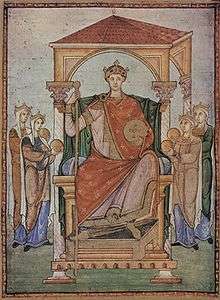Disc fibula


A disc fibula or disc brooch is a type of fibula, that is, a brooch, buckle, clip or pin used to fasten clothing that has a disc-shaped, often richly decorated plate or disc covering the fastener. Disc fibulae up to over 5 centimetres in diameter were usually part of women's attire in Europe in the Early Middle Ages; much smaller examples were also worn by men, however, from the Carolingian era. Well-known fibulae of this type date to the Migration Period and the centuries either side of it, for example the disc fibulae from Soest or the Lower Saxon village of Holle in Germany.
Many disc fibulae have gold ornamentation inlaid with gemstones, are enamelled or damascened, or are overlaid with gold or silver. The well known Pliezhausen brooch was once the cover of a disc fibula. An example from the Roman era is the Tangendorf disc brooch. The early mediaeval Maschen disc brooch portrays a figure with a saintly aureole.
 Alemannian disc fibula of the 6th century with almandine and bone inlays
Alemannian disc fibula of the 6th century with almandine and bone inlays Pair of disc fibulae from the Aregund grave c. 6th C.
Pair of disc fibulae from the Aregund grave c. 6th C.- Merovingian disc fibulae of the 6th and 7th centuries with gemstones and filigree
 Gold disc fibulae from the Sonnenbühl prince's burial mound (La Tène period)
Gold disc fibulae from the Sonnenbühl prince's burial mound (La Tène period)
Literature
- M. J. Bode: Germanische Scheibenfibeln. Ein kurzer Überblick über den Forschungsstand ausgewählter Formen. In: Jürgen Kunow (ed.): 100 Jahre Fibelformen nach Oskar Almgren. Wünsdorf, 1998, pp. 321–338, ISBN 3-910011-17-9.
- Heinrich Beck (ed.): Fibel und Fibeltracht. Sonderdruck aus Reallexikon der Germanischen Altertumskunde. Berlin, 2000, ISBN 3-11-016858-8.
Weblinks
- Search for Disc fibula in the German Digital Library
- Search for Disc fibula in the SPK digital portal of the Prussian Cultural Heritage Foundation (Stiftung Preußischer Kulturbesitz)